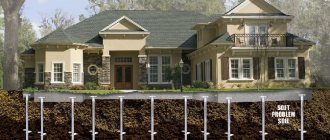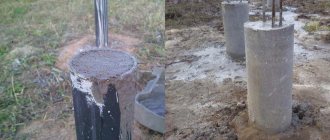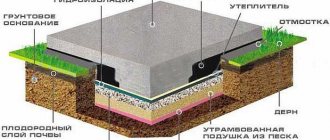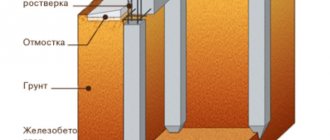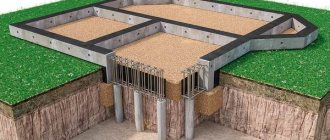It is difficult for a non-specialist to know which foundation to choose for a house. Traditional strip and slab laying is not used in all cases - there are a number of restrictions. In addition, they are quite expensive, which is not always justified economically.
A pile foundation with a grillage will require less investment, therefore, if conditions permit, it is more profitable to use it.
It seems that this is a house “on legs” Source sampochinil.ru
What is a grillage type pile foundation?
Such a foundation is a structure of piles buried in the ground below the freezing depth of the soil, and connected at the top using a metal or concrete strip (grillage). The supports can be combined by one common slab located at ground level or slightly above. The structure, built in accordance with all the rules, is reliable and has a long service life - several decades.
Concrete grillage Source domsdelat.ru
Here you can clearly see what a foundation grillage is - this is the entire upper part of any pile foundation, which is also called the “cap”. The purpose of the grillage is to evenly distribute the load from the load-bearing elements of the structure onto the piles and, accordingly, onto the ground.
There are several types of grillage:
- Made. It consists of separate elements, which are a structure of three piles reinforced with a welded frame. To install them, you will need a crane.
Prefabricated grillage from beams Source orchardo.ru
- Monolithic reinforced concrete. It is a solid plate or strip. Poured directly at the construction site.
Monolithic cast reinforced concrete grillage Source 24stroim-dom.by
- Prefabricated monolithic. An intermediate option, made from prefabricated parts, which in turn are assembled in a factory, and are already cemented in place using locks and key connections.
Calculating height above ground
The height of the pile foundation above ground level is determined by the height of the top line of the grillage.
Selecting the correct value is determined by several factors:
- Snow cover thickness in winter.
- Possibility of flooding, water level during spring floods.
- Groundwater level.
- Temperature conditions in the region.
By comparing these parameters, we come to the choice of the optimal height of the grillage.
The optimal values are considered to be 30-40 cm for conventional bases and 1.5-1.7 m in the presence of a basement.
IMPORTANT!
The possibility of equipping a basement room is extremely rare; most often, a technical underground is installed in which communications are located.
Advantages and disadvantages of a pile-grillage foundation
Each of the listed types of foundation has advantages and disadvantages that are taken into account during design in order to prevent excessive consumption of materials, deformations and cracks in supporting structures. Among the most common types of foundation, designers have a choice between strip, slab, pile-grillage and pile. If we compare the pros and cons of a pile-grillage foundation with other types of foundations, then SRF wins in many ways.
In fact, the advantages of a pile-grillage foundation far outweigh the disadvantages Source lowcarb-ernaehrung.info
The properties of a foundation with a grillage determine the following advantages of its use:
- applicable for any soil, including mobile and unstable, water-saturated or peaty;
- convenient when building a house in an area with uneven terrain (for example, on a slope);
- does not require large consumption of materials;
- has a significant service life;
- installation is slightly dependent on weather conditions - work is allowed at air temperatures down to -10°C;
- It is stable and has good load-bearing capacity.
On water-saturated soils, building a foundation requires special skill and accurate calculations Source termeszetvedelem.hu
Cons:
- there are restrictions related to bearing capacity: the foundation is used only for one- and two-story buildings;
- construction of a basement or basement is possible, but involves complex and costly design solutions;
- installation requires high precision, so it is strongly recommended to entrust it to specialists;
- installation work requires the use of special equipment.
Standards
When you get excited about the idea of building a house, it’s worth studying the building regulations. Below is a number of documents recommended for study before working on the project and installing the pile foundation. These standards will simplify the installation of the foundation so that it provides reliable support for the house.
- SP 24.13330.2011 “Pile foundations”.
- SP 50-102-2003 “Design and installation of pile foundations.”
- SNiP RK 5.01-03-2002 “Pile foundations”.
Each document specifies specific standards for the installation of pile foundations. Immersion depth, step between supports and much more. These documents can be intimidating, but it is a very good cheat sheet for beginners and even experienced builders.
Types of pile-grillage foundations according to the method of immersion in the ground
- Driven. The supports are driven into the ground using construction equipment.
- Printed. It involves drilling wells, which are subsequently filled with concrete.
- Screw. It is a method of screwing in piles using special equipment.
A special expense item is the use of special equipment Source blog-potolok.ru
See also: Catalog of companies that specialize in foundation repair and design.
Grillage technology
Installation of a grillage is the process of creating a load-bearing belt for walls.
Procedure:
- Construction of formwork. A durable gutter is installed from board panels, the internal dimensions of which repeat the cross-sectional shape of the grillage.
- The inner surface of the formwork is hermetically covered with a layer of polyethylene or roofing felt. This is necessary to prevent concrete leaks during pouring.
- The reinforcement cage is assembled and placed inside the formwork. It is welded to the armored well belt , forming a single frame for all elements.
- Concrete is being poured. The process must be completed in one go, breaks are not allowed. Pouring is carried out from different points, evenly distributing concrete along the entire length of the formwork.
- After pouring, the tape is covered with burlap or polyethylene and kept for 28 days. The formwork can be removed after 10 days .
- The finished grillage is carefully waterproofed and proceeds to further construction.
Types of piles used
Depending on the method of immersion, piles are selected:
- Hammers. For them, wells are prepared in advance, with a depth of 1/3 of the height of the pile. For installation, special construction equipment is used: pressing machine, vibratory hammer, vibratory hammer. Wooden, steel, reinforced concrete and hollow supports are used as driven supports.
Reinforced concrete piles: if the installation technology is followed, the supports will last for many decades Source block-gbi.ru
- Bored. Formwork and reinforcement are placed in the well for strength, then filled with concrete.
- Drilling. Wells are drilled in advance, into which reinforced concrete supports are then installed.
- Screw. They are hollow pipes, at the bottom of which there are blades and a pointed tip. The supports are screwed into the ground using special equipment.
UBM-85 for driving screw piles Source stroy-dom-pravilno.ru
Piles can have a rectangular or circular cross-section. The materials used for them are concrete, reinforced concrete, steel of various grades, and mostly coniferous wood. Of the tree species, larch is considered the most suitable, containing a large amount of resins that protect the piles from rotting.
Driven metal piles are one of the cheapest and most durable Source blog-potolok.ru
Pouring concrete solution
During all stages of construction work, you can immediately notice that screw piles for the foundation are a complete exception from all other foundations. The pouring process also differs from standard technologies. So, for example, instead of the traditional mixture of concrete grade M300, you should use M500, which is distinguished by its strength characteristics. As a result, you will be dealing with a rather thick solution. And it may take about six minutes to knead one batch. If possible, it is preferable to order a ready-made mixture.
When pouring, you must be extremely careful and approach this matter with the utmost care. So, for example, try to touch the reinforcement as little as possible, as this often leads to its shifting. Then, when the mixture is poured, it needs to be covered with plastic wrap. The structure should be left in this form for about one month. Next, you can remove the plastic film and the formwork structure. At this point, the construction of the structure can be considered completed.
Classification by depth
Depending on the position relative to the ground, there are 3 types of grillage:
- Low or recessed. Its peculiarity is that it is installed below ground level, that is, in the ground. The grillage is placed on a sand cushion.
- Ground. Located at surface level.
- Tall or hanging. It is located above ground level on high supports. If groundwater flows close to the surface, this type of grillage is used.
Recessed grillage Source nauka-i-religia.ru
Recessed grillages are used only in cases of extreme necessity, since their installation is comparable in complexity to installing a shallow strip foundation: it is necessary to dig a pit, arrange a drainage sand cushion, make formwork, but also install piles.
Unlike buried and above-ground grillages, hanging grillages are not as labor-intensive and, as a result, less expensive.
Device
The main part of the work on creating a pile foundation comes down to immersing the trunks in the ground.
This is the most difficult and critical stage, which determines the strength and stability of the entire system.
If failure, failure, or other problems occur during immersion, the ability of the entire base to perform its function is compromised. Any deviations during the work indicate non-compliance with the technology, unscrupulous geological survey of the site or low quality of piles .
The second stage is the creation of a grillage. It performs equally important functions and must meet all existing requirements.
The technology of creation directly depends on the type of piles, material of manufacture and parameters of the future house .
For light buildings, the grillage can be made of wood (a beam or a bundle assembled from an edged board until the desired thickness is obtained).
When using metal piles, it is customary to create a grillage from metal - a channel, an I-beam or a profiled pipe.
For reinforced concrete piles, the grillage is cast from concrete using a technology reminiscent of making a strip foundation.
NOTE!
Both stages of creating a pile foundation must be carried out by experienced builders or, at a minimum, under the supervision of a competent specialist. There may be violations of the technology or deviations from the calculated parameters , which must be noticed and corrected in a timely manner, which is not always possible for untrained people.
Stages of installation of a pile foundation with a grillage
The equipment of a pile-grillage foundation is divided into the preparatory stage and the installation itself. At each stage you have to perform several types of work:
Preliminary work
- To build a foundation, you first need a project , which is created on the basis of calculations of loads, the expected depth of immersion of piles, and what materials the foundation is planned from.
A project from a professional is a guarantee of safety, long service life, as well as savings in materials and finances Source nl.decorexpro.com
- Then the area is prepared : debris, topsoil and plant roots are removed.
- The territory is : the location of supports, grillage, load-bearing structures of partitions is noted.
Attention! Deviation from the project is always the cause of negative consequences, such as curvature of the foundation, the occurrence of unforeseen expenses, and more. Therefore, it is important that the project is drawn up by professionals and is tied to the area.
The work of a “professional” is immediately visible Source blog-potolok.ru
- A trench is dug for the grillage. Its walls and bottom are checked for evenness with a level. After this, a sand cushion is laid and compacted.
- Wells are drilled for supports , at the bottom of which a sand cushion is also placed. Waterproofing is placed in the pit: you can use a special film, several layers of roofing felt, or plastic pipes.
Technology for installing a pile-grillage foundation
- For the grillage, reinforced concrete beams are used or a monolithic tape is poured. A wooden rectangular formwork is prepared for it, which is secured with supports and lintels. At this stage it is also worth taking care of the sewerage and pipeline.
Photo of a pile-grillage foundation - after the concrete has dried, the formwork is removed Source bestroof.ru
- To increase the strength of the structure, a reinforced frame is placed in the well - 4 metal rods tied with wire. Then the concrete is poured. The tape is also reinforced.
- Next, concrete is poured first into the wells, then into the formwork. The concrete will take at least 10 days to set, after which the formwork will be dismantled.
How is the need for foundation materials calculated?
An accurate calculation can only be performed by a specialist - a civil engineer, who will rely on the requirements of SNiP and a number of indicators such as the strength of supports, grillage, bearing capacity of the foundation, soil resistance force, degree of shrinkage of the support under the influence of vertical load, etc. The specialist will determine the depth of immersion of the supports, their diameter, number, type of grillage and develop a diagram.
For a person without specialized education, calculations for a pile-grillage foundation look something like this Source ask.fm
When calculating the number of supports, they are based primarily on the load on the foundation, which consists of several indicators. Here it is necessary to know the mass of load-bearing walls, partitions, roofs, floor slabs, i.e. the entire mass of the building above the foundation. The payload produced by residents, household items and all other things is also taken into account. In calculations for private houses, an indicator of 150 kg/m² is used.
The last parameter for determining the total load is the weight of the snow mass that can accumulate on the roof in winter. The value generally used is 180 kg/m², but for a number of regions of the country it is slightly different. The resulting sum of loads is multiplied by the safety factor, which is 1.1 (sometimes 1.2 is used). Next, you can calculate the load on one pile.
It would not be out of place to add that online calculators for calculating materials that are widespread on the Internet should be treated very carefully. They may not take into account a number of important parameters.
DIY installation. Step-by-step instruction
When creating a pile-screw foundation for a house, the sequence of work has a strict sequence.
Pile foundation for a house, preparation
A pile-screw foundation can be created on uneven terrain that does not require prior leveling. It can be used in construction on slopes. Preparatory work boils down to clearing the area of bushes, plants and other interfering objects.
We make markings, marking the installation locations of the piles with pegs. At the installation points, recesses of up to 30 cm are made to facilitate the entry of the blades into the ground.
I recommend removing the fertile layer, as it creates strong resistance due to the presence of roots and other obstacles.
Preparing the ground for a pile foundation
Driving piles
If there is soft soil, manual installation is possible, otherwise mechanical installation. When driving manually, the maximum diameter of the shafts is 8.7 cm. The most commonly used piles are with a diameter of 10.8 cm. With the machine method, higher-quality installation of piles is obtained, maintaining a certain angle, screwing force and depth. The mechanical method allows you to work with piles up to 15.9 cm. This size is enough to build a fairly large house.
The piles are driven to a specified depth. When the required amount of adhesion to the ground is achieved, the pile begins to rotate with great effort, or stops rotating altogether. In this case, we stop the rotation, otherwise the welding may not hold up, the blades will fall off, and the pile will not perform its task.
Attention!!!
When working with screw piles, it is prohibited to reverse (unscrew the barrel back). This will lead to weakening of the adhesion of the blades to the ground and eliminates the possibility of re-immersing the pile in the same place.
Pile foundation for a house, strapping
So, all the piles have been installed, what next? Now we begin the pruning process. We adjust the height of the protruding piles to the same level, forming a flat horizontal surface. To do this, we use a laser level with the function of constructing planes at the required height and cut the pipes.
After the trimming process, the piles are filled with concrete, thereby increasing their strength.
Next, we install the grillage (banding) - a belt that connects all the piles into one system. We cover the cut piles with caps with horizontal platforms on which wooden or metal beams are installed.
For fixation on the platforms there are technological holes for bolted connections.
Important!
There are cases when the grillage and the trim are not the same thing. We carry out the piping below the grillage installation level and connect all the piles together, resulting in a system similar to a lattice. We use metal sections of channel welded to the walls of the trunks.
Harness
Installing additional items
When constructing a pile-grillage foundation, it is necessary to arrange openings for ventilation in the foundation and lay pipes that can be used for heating, sewer, water supply systems and other communications. If you do not take care of the engineering and technical equipment of the house in time, later to install them you will have to partially destroy the grillage.
To preserve the foundation, it is imperative to provide vents for ventilation Source remontstroy.net
Preliminary work
Before you make piles for the foundation, you need to do some preliminary work. As part of this stage, you should prepare some materials, among which the following can be noted:
- It is necessary to stock up on material from which the formwork structure will be created in the future;
- You should also prepare a tape measure;
- A drill with attachments for volume and length.
Filled pile
During the preparatory work, it is necessary to clearly mark the perimeter and also calculate the required number of pile supports. Next, excavation work is carried out, which is performed using a hand drill. This is not the easiest of stages, but it can be done with your own hands. A drill should be installed in the selected area, and slowly, using rotational movements, they plunge deep into the soil.
It is worth noting that it is necessary to remove the drill from the ground every thirty centimeters, after which it is shaken off nearby. If this condition is neglected, then after just one meter the drill will simply be impossible to reach. This is explained by the adhesion of too heavy a mass of soil. When the drill is completely inserted into the soil, you should remove and install one attachment. In the future, the manufacture of piles for the foundation involves repeating such actions until the drill goes to the required depth. Before completing such work, you should put specialized attachments on the drill, which make it possible to expand the installation platform. Thanks to the use of this option, it becomes possible to achieve the greatest increase in mass, which contributes to a colossal increase in load-bearing capacity.
If the choice fell on a permanent formwork structure, then a metal profile is perfect for these purposes. In addition, thanks to its design features, it is possible to achieve a significant extension of the service life of the columns. In this case, only one drawback is noticed - the relatively high cost.
Another solution is an insulating box made of polystyrene foam. This option is quite relevant in the northern regions. In any case, you can arrange the formwork for foundation piles yourself. The height of the resulting structure should be approximately twenty centimeters. In cases where there are significant unevenness of the ground surface, this value is taken as nominal. In other words, it is to this height that the remaining pile supports rise.
Requirements for creating a high-quality grillage foundation
Since the main loads on the grillage are bending forces, one of the key points when creating a grillage foundation is reinforcement, which significantly increases the strength of the structure.
Reinforcement diagram Source stroidominvest.ru
The second significant point concerns the hardening time of the concrete structure - which is a whole month. The grillage will be able to withstand the proper loads only after the concrete has completely hardened.
Common mistakes and tips on how to avoid them
Key points that novice builders miss:
Rejection of the geology of the site .
Directories and other sources do not provide reliable information about the soil characteristics in a particular area. To reduce financial costs, you can conduct research yourself, digging pits in several places on the site and visually determining the soil composition.- Refusal of reinforcement . The steel load-bearing frame ensures the stability of the supporting element against deforming forces arising in the soil. Concrete unreinforced piles are inferior to reinforced concrete elements in terms of strength and service life.
- Foundation calculations using computer programs only . Open access to services for calculating the parameters of a pile foundation is attractive for novice designers, but no calculator will take into account all the nuances of construction in specific conditions. If engineering calculations are too complex for the builder, it is better to order the design from professionals.
Everything you need to know about the design and construction of a pile foundation can be found here.
Possible mistakes when arranging the foundation
- The piles are not firmly attached to the grillage - thermal expansion during seasonal temperature fluctuations will soon loosen the fastening point.
- The piles are laid at too shallow a depth. Here, both excessive shrinkage of the foundation and squeezing out of loose piles in the layer below the freezing of the ground by forces of soil heaving cannot be ruled out. All this can lead to the destruction of the building.
- Inaccurate calculations. It's just a powder keg - you never know what might happen.
How to make a false base
The false base is designed to protect the space of the pile field under the house from the penetration of animals or birds, snow sweeping in winter, from wind and moisture. To create such a base, various materials are used.
The most budget-friendly and aesthetically attractive option is a strip of corrugated board along the outer perimeter. It is attached at the top to a special wooden board installed around the perimeter of the grillage.
The lower part is attached to a wooden beam laid on stands made of brick, cinder block, etc. to cut off contact with the ground.
A concrete ebb should be installed along the lower edge, and an ebb should be installed along the upper edge to drain rainwater.
Useful tips for installing screw piles
- The pile will not enter the ground strictly vertically; it will need to be constantly leveled and returned to the design position, so it is better that the work is carried out by at least three people: two act on the lever and one checks the accuracy. To prevent it from moving, special devices are sometimes used to fix it.
- If, while screwing, an obstacle or a layer of dense soil is found in the path of the pile, the penetration depth and location are analyzed. If it is not located at the corners of the house and you manage to insert it into the ground a meter or more, you can simply cut off the top and leave everything as is. With a depth of less than a meter, there is a possibility of the house skewing. At the corners, the piles should be installed to their full length, since these are the most critical areas.
- The final stage of installation may be concreting. It will provide additional reliability, but this process is not necessary in the case of screw foundations.
Finishing
Installation of the foundation can be combined with insulation. This will improve the insulation parameters of the building and help reduce the cost of maintaining comfortable temperature conditions.
First, the sheathing is secured between the piles. It can be made from galvanized metal profiles and wooden beams. For cladding, basement siding or profiled sheets are suitable. A layer of insulation is fixed from the inside.
Artificial stone finishing
If you build a brick wall, the cladding can be made of plaster
When studying the question of how to finish the basement, you should remember to maintain good waterproofing between the base and the building. If concrete or other heavy materials are used to construct the wall, it is necessary to add the appropriate weight to the load calculation. If necessary, increase the diameter of the pillars or reduce the pitch of their installation.
For what buildings is it needed?
Screw piles can be used for various buildings. World practice has shown the ability of this type of foundation to successfully work with massive, heavy and tall buildings and structures.
However, in Russia the technology for creating this foundation has not yet been developed, so they are usually limited to the construction of auxiliary or outbuildings. For residential buildings, screw piles are used reluctantly and quite rarely.
Pile foundation, screw
Strapping functions
Piles are pillars embedded in the ground, which without additional strapping manipulations do not exclude the occurrence of deformations. To avoid problems with the floor of the house during operation, it is imperative to use timber to tie the screw piles. The pillars are connected to each other and a strong and reliable foundation is obtained that can withstand the planned load. The binding of the piles is called a grillage.
The screw elements of a pile foundation are hollow tubes made of high-quality steel. The ends of the pole have conical blades with which the product is screwed into the soil. There are special holes in the pile. Before construction, the walls must be framed with timber on screw piles. Then the entire foundation structure turns into a single, strong system that can withstand the load intended for the foundation.
